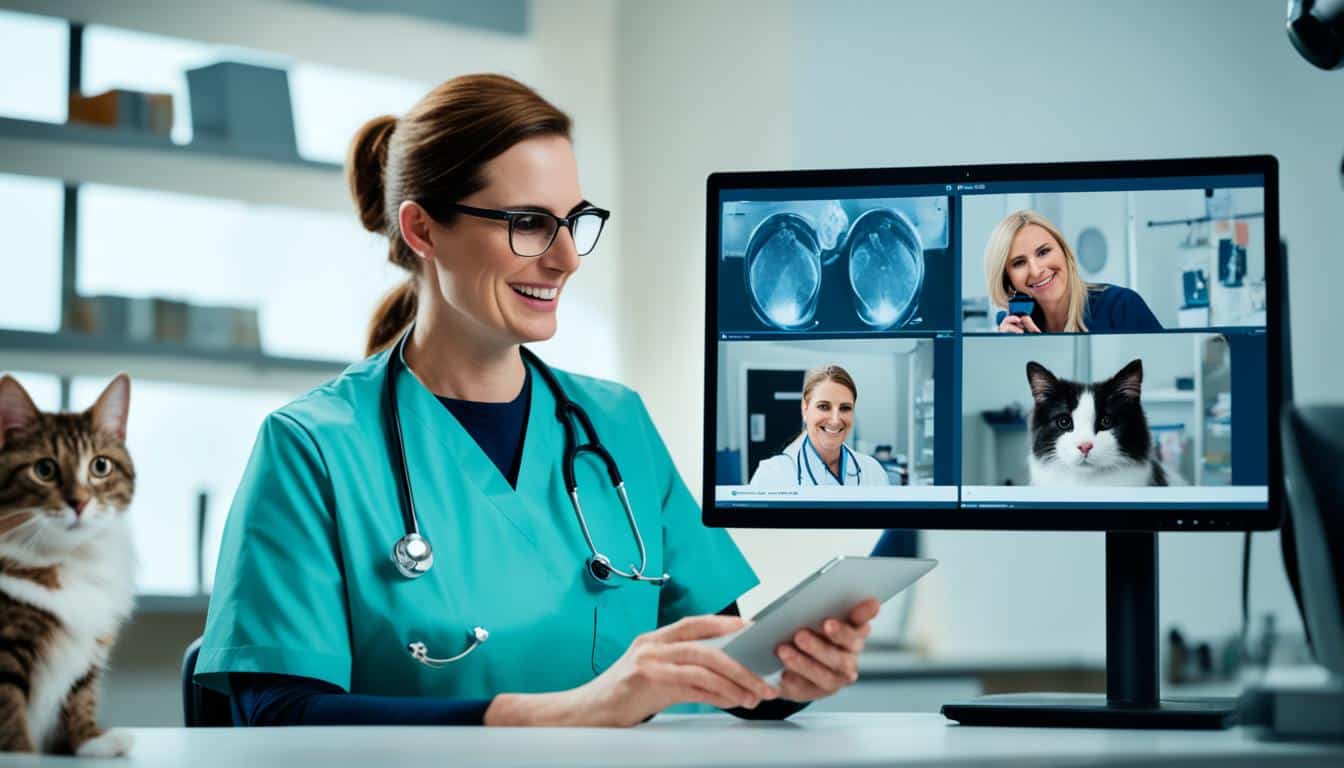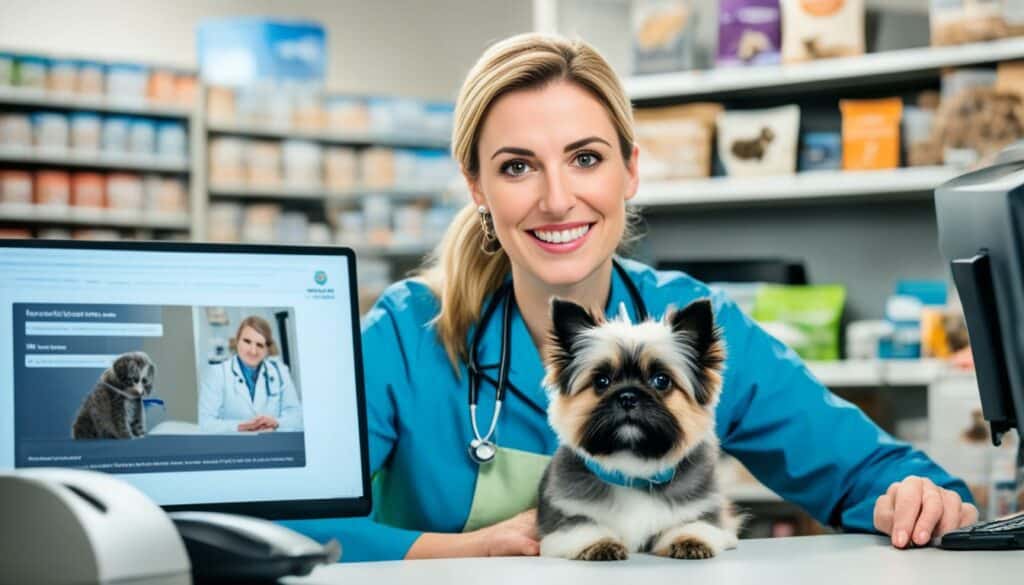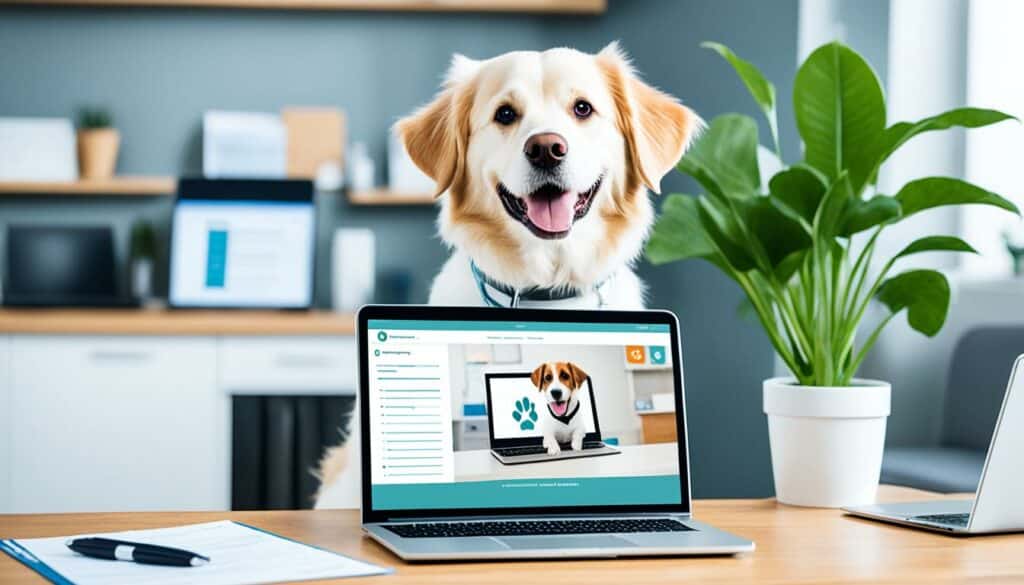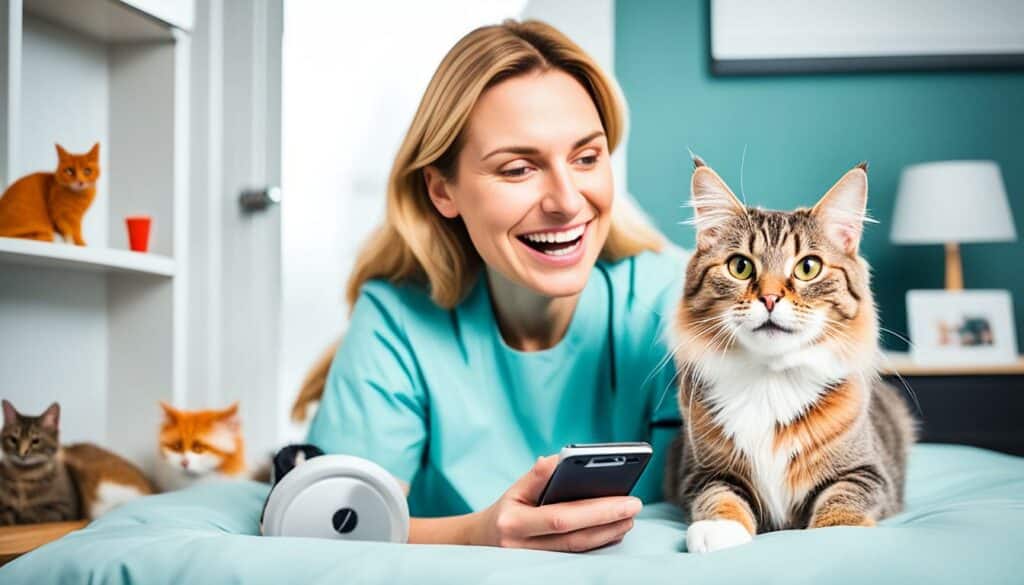Menu

Telehealth uses technology to deliver health information or care from a distance. It’s changing both human and animal healthcare. Now, pet owners can get real-time advice from vets via text, phone, or video. This approach is helpful when pet signs worry you, yet visiting in person remains important. Also, some areas allow Vets to diagnose and treat pets remotely.
The way we consult about pets online is getting better. By August 2023, Chewy will let users chat for free, showing a boost in remote animal care. This service is great for getting advice on not-so-urgent pet issues. It’s a big step in managing our pets’ health from afar.
Veterinary telemedicine is changing the way pet healthcare works. It connects the traditional vet visit with the ease of now. Services use technology to give advice and *consultations* about pet health from a distance. This makes it easy for pet owners to get the care they need.
Veterinary telemedicine is different from tele-triage. The former includes diagnosis and treatment. The latter helps pet owners know if they need to see the vet in person. Telehealth for pets covers both, ensuring pets get the right care when they need it.
More and more vets are turning to digital consultations. They use tools like Skype and apps to talk to pet owners and do check-ups online. This change allows for various services, like consulting with experts, monitoring pets from afar, and quickly assessing health issues.
The laws around telemedicine are also changing. Vets must follow state rules and make sure their online care meets the needs of their patients. They’re also starting to prescribe medicines online. But, they still need to follow all the usual rules and laws.
Veterinary telemedicine involves different types of communication. This can be between pet owners and vets, by phone or video. It’s important that the vet is licensed in the state where the pet lives. They can work from their clinic or a special telemedicine platform.
Telemedicine isn’t a full replacement for regular vet visits or emergencies. But, it’s really good for small health issues like an upset stomach or a little cough. It also helps with advice on food and how to deal with behaviour problems. Plus, it’s great for checking up on long-term health conditions.
The world of veterinary telemedicine is getting better all the time. It helps with busy schedules and can make pets feel less stressed. But, there are still times when a face-to-face visit with the vet is needed for a complete check-up.
Veterinary telemedicine is changing how we look after our pets. It uses modern tech to offer help that fits our needs. It’s affordable and stress-free for pets, making it popular among pet owners.
Veterinary telemedicine saves money on pet care. Studies show people are happy to pay extra for online vet advice. It makes sense because these is cheaper and helps avoid many trips to the clinic.
Thanks to more telemedicine options, vets keep more clients. This is good news for their business.
Telemedicine makes it easy to get vet advice from anywhere. You don’t have to deal with travel or fit appointments into your schedule. A lot of pet owners think this is better than a visit to a clinic.
This trend will likely continue after the pandemic. It shows that people want easy and flexible pet care, wherever they are.

Virtual vet services cut down on the stress of going to the vet, especially for cats and their owners. Instead of a scary trip, your pet can get help at home. This makes them more relaxed and makes pet owners happy, too.
The Canadian Veterinary Medical Association supports this approach. They want to make sure pets and their owners benefit from remote vet care.
| Survey Findings | Percentage |
|---|---|
| Curb-side visits effective | 86% |
| Prefer curb-side to traditional | 28% |
| Willingness to continue curb-side | 48% |
| Client turnover reduction with telemedicine | From 13% to 3% |
Telemedicine is changing pet care for the better. It shows how tech and convenience can improve healthcare for our furry friends.
In the world of veterinary telehealth, different services are there for pet owners and their pets. These services use technology to make animal healthcare better and easier remotely. Let’s look at the main types of services.
Teleadvice gives general health information and recommendations. It’s not specific to your pet’s condition, unlike private consultations. This service helps pet owners with everyday care and prevention.
Teletriage deals with assessing and managing a pet’s symptoms from afar. It helps work out if your pet needs to see a vet right away or can wait. This can limit unnecessary trips to the vet and lower stress for your pet.
Teleconsulting lets a primary care vet talk to specialists about your pet’s health problem. It involves online meetings with vets and other professionals, giving a team effort for complicated issues. This way, your pet gets expert care without multiple specialist visits.
Telemedicine aims to directly help your pet’s health through online medical sharing. It works under a vet-client-pet relationship, offering services like online vet chats and monitoring chronic conditions.
| Service | Description | Application |
|---|---|---|
| Teleadvice | General health guidance | Nutrition, preventive care |
| Teletriage | Initial assessment and management | Determining need for vet visit |
| Teleconsulting | Specialist consultation with primary vet | Complex health issues |
| Telemedicine | Clinical health improvement | Chronic condition monitoring |
These telehealth services meet various pet health needs, from simple advice to chronic care. With teleadvice, teletriage, and online consults, we’re changing pet healthcare for the better.
Virtual vet visits are becoming more popular. Platforms like TeleVet, Chewy, and Pawp offer remote pet health advice in the USA. Users can easily get top-notch help from these services at home.

Now, let’s look at what these platforms uniquely offer:
| Platform | Services | Cost |
|---|---|---|
| Chewy | Connect With a Vet, Free chats for Autoship customers, $20 for video calls | $20 per call for non-members |
| Pawp | Annual subscription with an optional emergency fund, 24/7 access | $99/year, plus $19/month for emergency fund up to $3,000 |
| Dutch | Chronic condition treatment, connects with specialists, prescription medications | $132/year or $35/month |
| Airvet | Emergency veterinary services, instant access | $35/month or $75 for a single video chat |
Chewy stands out with its ‘Connect With a Vet’ service. It’s great for quick advice but costs $20 if you’re not an Autoship member. This service is well-liked for its easy use and clear pricing. Dutch focuses on ongoing pet health issues and offers a set price for monthly or yearly service. Airvet shines with its quick, emergency care, perfect for sudden needs.
For financial protection, Pawp’s yearly plan includes a medical fund. This fund and the access to vets at any time help look after pets in unexpected health scares.
Each platform brings something special, like Chewy’s low-cost talks, Dutch’s detailed health management, or Airvet for emergencies. Pet owners can pick what suits them to ensure their pets are well cared for, even when they can’t go to the vet in person.
Deciding when to turn to telemedicine for your pet is key to keeping them healthy. This method lets owners get advice quickly. It’s useful when a visit to the vet’s office is not possible right away.
The big plus of telemedicine is that you can keep an eye on your pet from a distance. This works well for health issues that aren’t emergencies. It lets you check symptoms, give medicine, and make sure your pet is okay without leaving home.
Tele-triaging works by checking your pet’s health over the internet. It helps you find out if your pet needs to see the vet right away. This way, important health issues are caught early.
Tele-triaging doesn’t just give peace of mind. It also saves money and the hassle of going to the vet in an emergency. It lets pet owners decide what’s best for their pets’ health without too much worry.
| Telemedicine Service | Application | Benefits |
|---|---|---|
| Remote Monitoring | Monitor symptoms and medications remotely | Convenience, Continuous Care |
| Tele-triaging | Assess urgency of health concerns | Peace of Mind, Cost-Effective Solutions |
| Follow-up Care | Post-treatment consultations | Efficiency, Ongoing Support |
For non-emergency pet health issues, think about telemedicine first. It’s great, but remember, at times, your pet needs to see a vet in person. Using these services wisely can mean the best care for your pet, with no extra delays or worries.
Telehealth for pets brings many benefits, changing the game in veterinary care. It allows easier access to care for pets that don’t like travelling or busy owners. Online vet services offer a simple way to get advice without going to a clinic.

TeleVet and Pawp are two standout services. They let vets check animals over video calls, which is great for pets that find vet trips stressful. This new approach helps more pets get the care they need.
Vet telemedicine includes many types, like remote check-ups, advice, and even e-prescribing. This huge variety means there’s something for every pet’s health needs.
Teletriage is a good example. Vets can decide how urgent a pet’s health issue is without seeing them in person. E-prescribing makes getting medicine easier by doing it all online.
Then, there are apps and gadgets that track a pet’s health at home. These tools help keep pets healthy and also educate their owners. This blend of tech and vets is the future of animal care.
Around the world, more and more pet owners are open to telehealth. A US survey shows many would pay for virtual vet visits. Plus, most think curb-side services, where the owner stays in the car, work well.
Using online vet care can also save money. It cuts down on travel costs and lost earnings from missed work. With more telehealth, there can be less strain on the vet workforce too. This all means better care for pets.
Going to the vet can be stressful, especially for older or very sick pets. Telehealth can make these visits fewer, reducing worry for everyone. The future of pet health looks brighter with remote veterinary care.
When looking at the world of veterinary telemedicine, several key services offer unique benefits. TeleVet, Chewy, Pawp, Dutch, and Airvet are some of the leaders. They are known for meeting pet owners’ needs all across the United States. These top services offer different accessibility levels, prices, and care options.
TeleVet is loved for its easy-to-use platform, making it simple to video call local vets. The cost for each use depends on the vet’s clinic. It lets vets and pet owners chat easily, saving on travel time for minor issues.
Chewy’s “Connect with a Vet” lets you chat with a vet for free. This is very handy for quick advice. Video calls with a vet are free if you’re signed up for Autoship, and £20 for others. This makes getting help fast and affordably a reality for any pet owner.
Pawp offers a special annual membership at £99. This includes all your pet’s care, plus an emergency fund you might want to add for £19 a month. It’s perfect for anyone who wants to make sure their pet is always covered, even in a sudden emergency.
Dutch is great for pets with ongoing health needs. It can even provide prescriptions in certain states. It costs £132 a year or £35 monthly, without any long contracts. Dutch makes it simple to keep your pet’s health in check all the time.
Airvet is all about getting fast advice when you need it most. For £35 a month, you can use it as often as you like. Or for £75, you can have a one-off video call. It’s ideal for sudden health worries, ensuring you get help from a professional vet straight away.
| Service | Cost | Features |
|---|---|---|
| TeleVet | Varies by practice | Easy local vet connection |
| Chewy | Free for chats, £20 for video calls | Instant text-based advice |
| Pawp | £99/year + £19/month for emergencies | Continuous care and emergency support |
| Dutch | £132/year or £35/month | Managing pets’ long-term health issues |
| Airvet | £35/month or £75 for a single chat | Emergency advice whenever you need it |
From the adaptable TeleVet to fast-access Airvet, these services show the great variety in telemedicine. Chewy is well-liked for its free chats and low-cost video calls. Meanwhile, Pawp ensures continuous support and Dutch focuses on chronic conditions.
If you want more detailed information, check out this comprehensive guide on veterinary telemedicine services. It gives in-depth information on what each platform offers.
The use of digital veterinary consultations is growing. It helps pet owners get expert advice without going to a clinic. Platforms like AskVet lead this change, offering help for all kinds of pet problems.

Remote advice for pets includes tele-triaging. This lets vets check how urgent a pet’s symptoms are. It’s great for quickly deciding if a pet is okay or needs immediate care.
Tele-consulting lets general vets get advice from specialists. This improves the care they give. It also includes getting advice on general health, like suggesting yearly check-ups for pets as preventive care.
Telehealth under telemedicine focuses on sharing medical info online. This is useful for follow-ups after surgeries. It makes managing a pet’s health easier in the long run. And, e-prescribing makes getting and sending prescriptions faster than writing them out.
In pet health, mobile apps are becoming key. They help vets, owners, and pets stay connected. Plus, these apps provide info and tools that help monitor pets’ health without a visit to the clinic.
| Service Type | Description |
|---|---|
| Tele-triage | Assessing and managing urgency based on reported clinical signs. |
| Telemonitoring | Remote monitoring of vital signs and behaviours. |
| Teleconsulting | General practitioners seeking specialist insights. |
| Tele-advice | Providing general health guidance or recommendations. |
Remote pet advice brings together many parts of care. This new way of helping pets boosts their wellbeing. It also helps their owners get quick, expert advice, improving their pets’ health.
Building an online VCPR is crucial in the world of veterinary telemedicine. Dutch is at the forefront in remote diagnostics and treatment, all within legal limits. Yet, the rules differ greatly from state to state.
The use of telemedicine to create a VCPR is a hotly debated issue. The FDA tells the AVMA that a VCPR can’t be set up solely online. States follow the AVMA’s model law, saying a VCPR can’t be telephonic or electronic only. However, once established, it can be kept up online. So, knowing your state’s rules on veterinary care is key for playing by the book and looking after pets well.
A strong VCPR betters pet health care by ensuring vets know enough to make smart health decisions. Federal rules say a VCPR is needed for unique drug uses, certain feed directives, and biologics. This link is key for watching over treatments and making sure everything is as it should be. This all ups the level of care pets receive.
Keeping up care in a VCPR is vital for pets with health issues that need ongoing attention. Vets can stay connected and see their patients regularly, even from afar. State laws often stress the need to keep patient records meticulously, showing how a good VCPR is a solid step in following the law while caring for animals.
Managing your pet’s health from afar is now easier with digital vet consultations. These consultations are great for issues like small skin problems, tummy troubles, and odd behaviours. By using these services, you can deal with minor and long-term health issues without rushing to the vet’s office.

They are also good for dealing with ongoing problems like allergies and being anxious. Talking over video and checking in virtually are key parts of giving good care remotely. This way, vets can give the right medicines and care while following the law. It’s also an easy method for getting your pet’s medicines to them quickly, without you needing to leave the house.
Let’s dig deeper into how well each area of telehealth works:
| Telehealth Category | Description | Commonly Managed Conditions |
|---|---|---|
| Teleadvice | General health advice not specific to a single pet. | Behavioural issues, general care tips |
| Teletriage | Assessment to determine the necessity of an in-person visit. | Minor injuries, sudden symptoms |
| Teleconsulting | Consultations between primary care vets and specialists. | Complex cases requiring specialist input |
| Telemedicine | Direct management of clinical health through digital communication. | Chronic conditions like allergies, anxiety |
In the USA, the use of telemedicine in veterinary care is growing fast. It includes things like keeping an eye on your pet’s health from a distance, sending prescriptions online, and using mobile health apps. These tools are changing the way we care for pets, making vet services more accessible and better. This is especially true for health issues that can be treated well without visiting the vet in person.
Looking at the veterinary telemedicine law in the USA shows it’s complex. Each state has its rules for how vets can work with pet owners and treat animals from a distance. To offer legal considerations for veterinary telemedicine, it’s vital to know and follow these laws.
States in the USA set their own rules based on the AVMA Model Veterinary Practice Act. They might include needing to see the animal in person before using telemedicine. This is to make sure a full and proper assessment is done.
Arizona is unique, allowing a VCPR to start online. This reflects a more modern approach found in states like Idaho, New Jersey, Vermont, and Virginia. On the other hand, some like Michigan and Alaska now ask for an in-person check-up. California is also looking into this with Bill AB 1399, which might change the rules about needing to meet animals face-to-face before treating them online.
The AVMA Act says a VCPR can’t be set up just by phone or online, except in some emergencies. For drug prescriptions or using Veterinary Feed Directives, vets need to have met the animal in person. And to treat animals across state lines, they need licenses in both states.
It’s okay to use some types of online services, like video calls, under certain conditions. If a specialist helps by telemedicine, they usually need the vet’s permission if they already have the right qualifications.
As veterinary telemedicine laws change, it’s vital for companies and professionals to keep up-to-date. This way, they can provide good telemedicine services that also meet the legal rules.
Starting a virtual vet appointment right can make it smooth. Here are some virtual vet service tips for a good consultation:

When the appointment starts, help the vet as much as you can. This could mean showing your pet to the camera or talking about their symptoms. Being involved can make your virtual vet consultation go well.
By following these virtual vet service tips, your appointment will go better. You’ll be actively helping in your pet’s health care. This way, you and your pet will get the most out of the meeting.
In the United States, telehealth in vet practices is growing fast. This is thanks to digital tech improvements. These new tools are changing how vets care for animals and how owners keep track of their pets’ health.

Video conferencing software is leading this change. It lets vets see pets in real time and plan treatments with owners. Tools like Zoom and Microsoft Teams have become key for continuing care, especially when quick in-person visits aren’t possible.
Wearable tech is also making a big difference in vet telemedicine. Devices such as PetPace collar or FitBark let vets keep an eye on pets’ health around the clock. This tech allows for quick actions and specific care plans, using up-to-the-minute data.
Mobile apps are a must-have for looking after pets. They help owners keep medical records, book appointments, and remember medications. Apps like PetDesk and MyPet Reminders make these tasks easy. They bring everything together, making pet healthcare more efficient and complete.
Virtual vet services bring many good things, but they have some big limits too. The main problem is they can’t do checks or give shots over the internet. This makes it hard to know some illnesses for sure without seeing the pet face-to-face.
There’s also a big hurdle with the law. Different places make different rules about when a vet can talk to a pet owner online. Some allow it without meeting in person but others need that first. This makes things tricky for anyone wanting telemedicine for their pet.
Then, there’s the challenge with technology itself. Not everyone can get good internet or knows how to work all the tech stuff. So, some folks, especially in far-out or poor areas, might miss out on virtual vet help.
Another worry is about giving the right amount of medicines online. Sometimes, too much antibiotic is prescribed. This can make germs stronger and more dangerous for everyone.
Virtual vet chats seem cheaper but can lead to more costs later if you have to visit in person. This could mean you pay twice. Also, not meeting in real life makes it harder for vets to spot things about the pet’s health and behaviour.
So, there are lots of issues with virtual vet care. But, helping pets better online and offline is possible with new ideas and rules. The way we take care of pets is changing for the better, mixing both online and real-world care.
The way we look after animals is changing fast. Soon, we’ll be able to do a lot more for them without leaving home. This change is coming through new tech and better laws. It’s all part of a big shift in how we see and give vet care.
Looking ahead, we see big changes in how we care for our pets. Soon, vets will use things like:
Laws are really important in making these changes safe and effective. They make sure vets use new tech in the right way. The pandemic has made us use remote vet care more, showing us how important and helpful it can be.
New tech like using smartphones for health care, checking on patients without being there, and getting advice from other vets, are all part of these changes. They help vets know exactly what each pet needs. This makes the care they give better overall.
E-prescribing, where vets can send and receive prescriptions online, is another way tech is making things easier. Also, getting health advice and figuring out how quickly a pet needs care are becoming easier with remote help.
It’s clear that the future of how we take care of animals is looking brighter. These new tools and ways of working can make vet care more connected and better for everyone.
| Aspect | Current Trends | Future Projections |
|---|---|---|
| AI Diagnostics | Initial Deployment | Widespread Use |
| Wearable Technology | Increasing Popularity | Universal Adoption |
| 3D Printing | Emerging Applications | Routine Customisation |
| Cloud-Based Systems | Growing Integration | Standard Practice |
| Continuous Training | Essential Requirement | Advanced Specialisations |
In wrapping up our look into veterinary telemedicine, we find it’s more than a passing fad. It signals a wider move towards using digital tools in pet health. Consider this: less than 20% of the 20,000+ telemedicine consultations in the U.K. led to a written prescription. And only 2% needed oral antibiotics. This shows a push towards using fewer drugs when they’re not truly needed.
Telemedicine is a game-changer for pet owners facing barriers to traditional vet visits. Nearly 60% of those using apps without an established relationship with a vet sought follow-up care. After telemedicine consults, about 90% felt they knew more. This indicates high satisfaction and a big need for easily accessible vet advice.
The future looks bright for telemedicine in animal care, with 75% of users already having a regular vet. And 82% of these vets agreed with the advice from the telemedicine vets. This solid agreement shows digital pet health advice is trusted and useful. People enjoy the convenience and less stress for their pets.
Moving ahead, including virtual pet care will make help more available and slice care gaps. It’ll also bring in new ways to handle ongoing and routine health needs. With new tech and support, we’re on the edge of an exciting phase in pet healthcare. Efforts like Pets for Life and partnerships with vets show we can do more to reach those in need.
Veterinary telemedicine platforms provide online pet consultations. They also offer remote animal health care and teleadvice. You can find services like general health advice as well as specialised consultations.
No, it can’t replace visiting the vet in person. It’s not possible to do physical exams, vaccinations, or surgery this way. But, it’s great for getting guidance on non-emergency issues.
Virtual services bring cost-effective care and less stress for pets. They offer professional advice without travel. They’re handy for those who can’t easily visit a vet.
Teletriage helps figure out how urgent your pet’s condition is. It can advise if a direct visit to the vet is necessary. This can give pet owners peace of mind in emergencies.
Top platforms include TeleVet, Chewy, Pawp, Dutch, and Airvet. They provide unique services like free text consultations and instant emergency access. Each one caters to different pet owner needs.
Such consultations work for issues that don’t need a physical exam. This includes skin irritations, digestive problems, and behavioural issues. They also help with ongoing conditions like allergies and anxiety.
Establishing a VCPR online lets vets recommend treatments and manage conditions from afar. But, doing this online depends on each state’s rules. It’s about using digital means to support the pet’s well-being.
They use video calls for live consultations and wearables to check on pets. Mobile apps help keep medical records up to date. These tools allow for better pet care plans from a distance.
Challenges include not being able to do certain exams or give shots virtually. Also, there are legal issues in different states. Bad internet and not being tech-savvy can also be issues.
Future care will likely become more available and advanced. Diagnostic tools will get better, and laws will improve. This aims to make vet care more personalised and accessible.